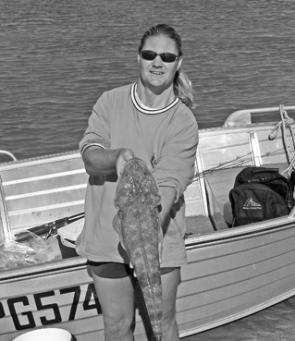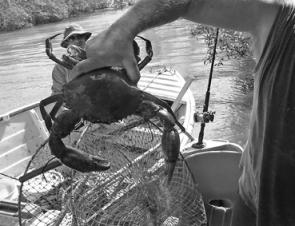The queenfish that I mentioned last month have come on in better numbers than previous years in various spots and it’s been great fun!
The front wall at Rosslyn Bay and the corner at Iron Pot, well known locations for spotted and doggie mackerel, are both holding queenies in quantity contrary to patterns of the past. The regular queenfish haunts have been consistently providing plenty of action for the light gear fishers.
Deep Creek has a shallow winding channel that runs between sand banks and along a muddy mangrove bank. This combination attracts a variety of species ranging from barramundi, bream, flathead, salmon to trevally and queenfish. Bait schools hang off the main channel and as they move to the next hiding spot when the tide drops or rises, the predators attack.
At the moment queenfish are ruling the area and are giving the small mullet and herring a flogging. The majority of anglers fishing for queenies often use livebaits. The availability of greenback herring, especially in the immediate area, is probably the best reason. In this particular location you are protected from the heavier winds allowing a good drift pattern when lurefishing.
Salmon Rocks in Corio Bay is another solid place to target queenies. Towards the top of the tide drifting along past the rocks down towards the Black Banks will almost guarantee a queenfish everyday. They never get real big here but nobody complains about 1.5-2kg fish. The bigger queenfish prefer the islands and the headlands.
Corio Heads right on the northern end of Corio Bay has several large bombies where the large queenies come to grab a feed in whitewater. Drifting with a live herring just off the bottom works well. I like throwing a big popper into the wash and watching it scream back towards the boat. The visual thrill of the queenies nailing the popper right at the boat is awesome.
Fishing the islands is the most relaxing method of all. The rocks around the islands have schools of hardiheads in residence most of the time and the queenies take advantage of the tides for an easy feed. A cast net, bucket, rod and some tackle is all that you will need. Sitting on the beach with a cold drink and livebait set waiting is the ultimate pastime. It normally doesn’t take long before you land a queenfish.
Queenfish or skinnies will take soft or hard-bodied lures and chromies. Minnow lures worked quickly can do the job, while poppers need to be screaming across the water making a lot of noise and creating bubbles. Chromies worked in an erratic jigging motion and soft plastics require a soft approach. When using soft plastics for queenies cast out past where the fish should be, let the lure sink to the bottom, give a couple of short sharp twitches, let it settle and then repeat. Colours don’t really make a big difference but green plastics have been the most productive. Minnows, like the pilchard coloured Bombers, are a favourite and poppers with a blue top and white bottom or green and yellow have had the best returns.
Flathead have continued to top the estuary count, mainly due to catch and release practices. These days most people only take what they need and the results are showing in reports from all around the area.
Trolling and throwing lures while drifting has continued to provide the goods. When you can get a drift slow enough, it’s best to cast in front of the boat and work the lures back slowly. This method doesn’t spook the fish as you go over the top of them. Normally the smaller fish hang right up in the shallows while the larger specimens hold slightly deeper in the channels. Pick a line where there is a depth change and work the edges.
Muddies may have slowed over the cooler months but now as the water is warming they are coming out to feed again. At present most of the crabs are floaters with the odd full crab amongst them. In this dry part of the year try up into the smaller creeks and in the mouths of the smaller systems.
The run of an unusually warm winter has continued into spring and the weather patterns normally associated with this time of year have been irregular leaving few chances to head wide. The coming month looks to be settling to a more regular pattern and with it the opportunity to get among the bigger fish. The wider grounds have turned up quality red emperor, red jew, rosy jobfish, parrot, coral trout and sweetlip. The grounds out from here that have been producing are the rubble beds and low reef covering large areas. A good sounder is a must to pick up small changes in the bottom where the reefies feed.
We have a general plan that works most times: pick a direction and watch the sounder screen. Time and again we have located new places to fish that other guys go straight past. There does not have to be much of a variation to attract fish. Bait schools mean more than structures alone and where there is bait, predators lurk.
Night fishing is another option for finding better bottom fish if the tides and run are right. Heading out before daylight and on dark is a common belief, but this isn’t always the case. When the conditions allow even the middle of the day can be a bonanza. In October last year some of our best catches of reef fish came following a mid-afternoon tide change long after the other boats had left for home.
October is the main month for spotted mackerel. They linger here a little longer than their run earlier in the year. They come into the bay in masses if the water is relatively clean and if not the islands and the shoals get the numbers. Pillies and chromies share honours in local spotty captures. Queensland school mackerel or doggies have dropped in quantity, but the odd school mackerel will hang around till December.
Spanish mackerel have been a bit hit and miss lately except for those fishing the wide grounds or contour lines. They will move from each spot and the fish caught in close won’t be in huge numbers. Mack tuna schools have also appeared lately and as the month wears on more will pass through the bay. They are a brilliant sportfish and the occasional fish kept makes top reefy bait.
This month is The Rocky Barra Bounty the barramundi have started chewing just in time. From now on barra, mangrove jack and fingermark will increase steadily in local catches.
Reads: 3899
Bill Lewis caught this mack tuna at Forty Acre.

Brett Robinson with a fine Corio Bay flathead.

Peter Sutton with a small common trevally.

An early season muddy getting put back because it is empty.




